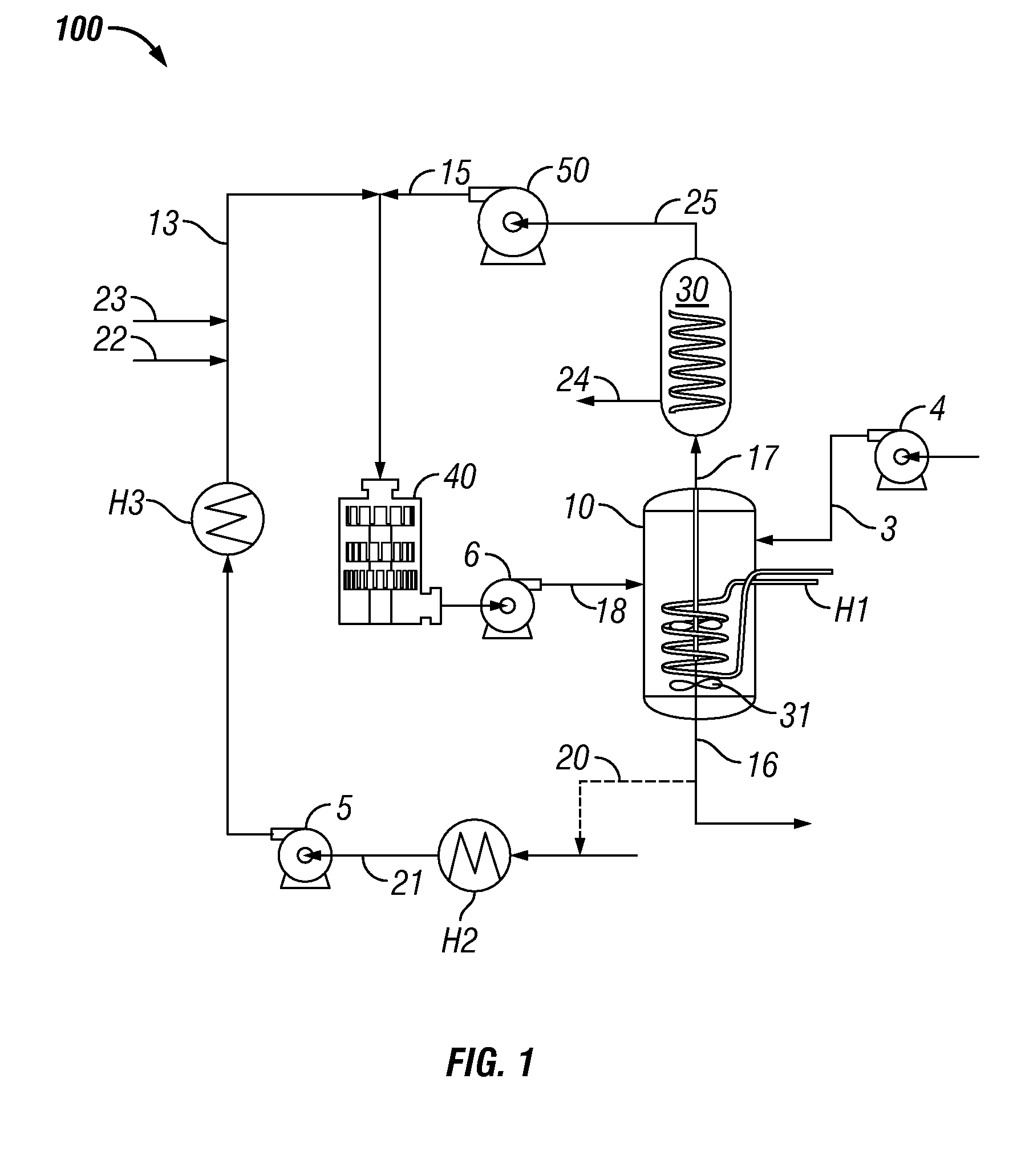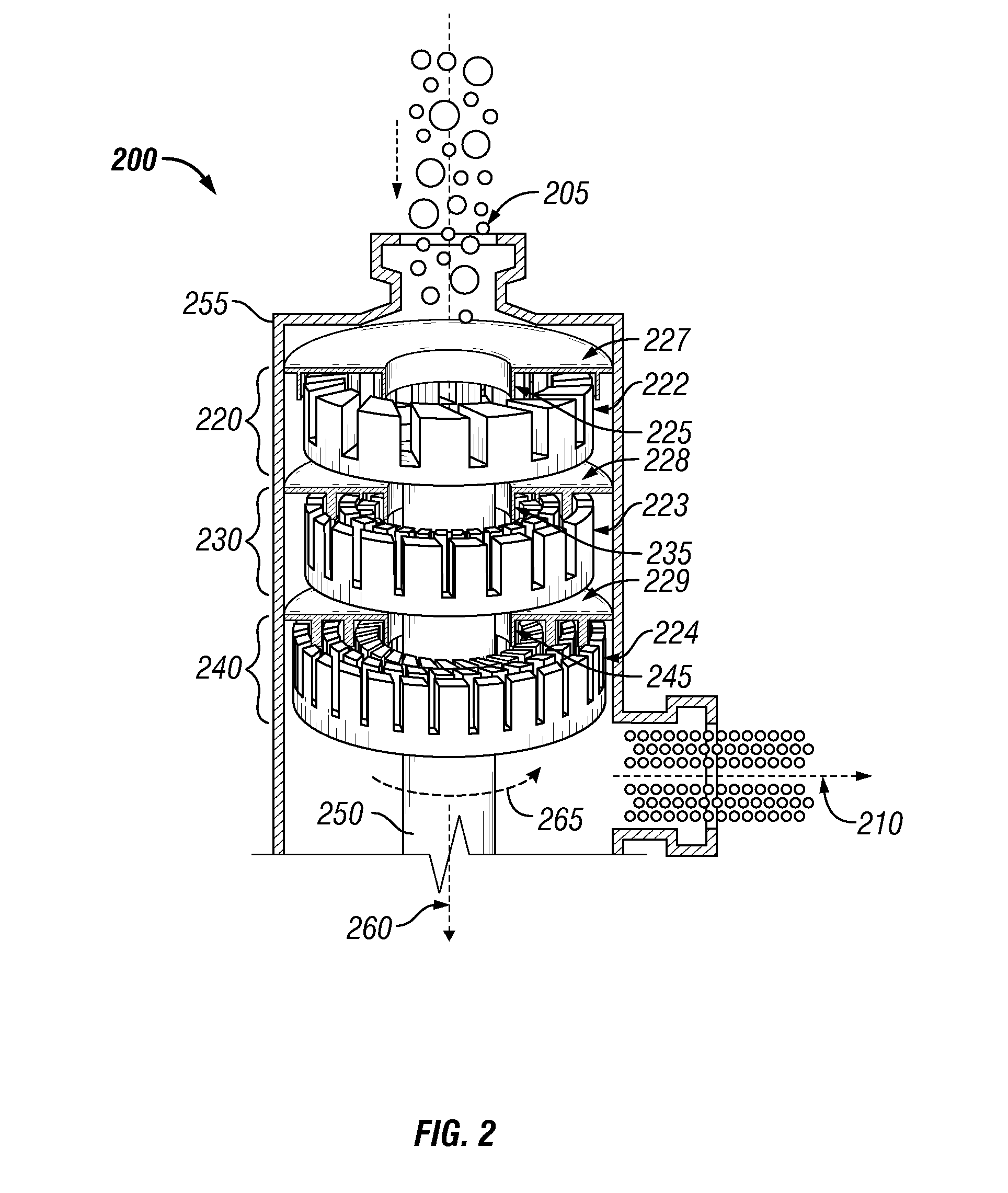System and process for production of liquid product from light gas
- Summary
- Abstract
- Description
- Claims
- Application Information
AI Technical Summary
Benefits of technology
Problems solved by technology
Method used
Image
Examples
example 1
Catalyst Preparation Method
[0117]Catalyst MR-34-18 in Table 1 hereinabove was prepared in a 500 mL beaker, using 9 grams ammonium tungstate (99.9% purity from Sigma-Aldrich Co., St. Louis, Mo.) and) and 1 g lanthanum nitrate (Fisher Chemicals, Co., Fair Lawn, N.J.) that were dissolved in 200 mL deionized water at 70-80° C. In a separate beaker cobalt (II) nitrate hexahydrate (from Sigma-Aldrich Co. 99% purity) was dissolved in water at 70° C. The two dissolved salt solutions were then combined and 30 g of manganese (IV) oxide (reagent plus purity, 99% from Aldrich) added with 10 mL ammonium hydroxide (A.C.S. reagent grade from Sigma-Aldrich Co.) to achieve an alkaline pH. The mixture was heated at 80° C. and the paste formed was transferred to a glass plate and heated for 2-3 hours in an oven maintained at 120° C., which caused the formation of a coat or thin layer on the manganese oxide.
[0118]The dried catalyst was placed a crucible for calcination. The calcination furnace was cont...
examples 2-4
Methane Conversion
[0121]An experiment was performed over 36 days to evaluate the production of oxygenates and liquid hydrocarbons via the disclosed system and method. The experiment log for the testing is provided herein as Appendix A. The temperature of vessel 10 during the experiment ran between 150° C. when started to about 80° C. on the last day of the experiment. The power meter consumption at 7500 RPM was 0.15 KW / h when the vessel 10 temperature was 80-100° C. During start-up of cold trap 30, the power consumption was 0.17 KW / h. When the temperature reached 146° C., power consumption dropped to 0.14 KW / h. At maximum shear of 104 Hz (13500 RPM) on high shear device 40, the power consumption on cold PEG was 0.27 KW / h. When the temperature was between about 80° C. and 100° C., the power consumption was 0.24-0.25 KW / h. Throughout the experiments of Examples 2-5, the gas mixture was 345 kPa (50 psig) and comprised a 2:1 volume ratio of methane:carbon dioxide, unless stated otherwis...
example 2
High Shear Reaction of 2:1 Methane:Carbon Dioxide with Ruthenium Carbonyl
[0122]A cold trap was positioned within system 100 as shown in FIG. 1. Five (5) grams of tri-ruthenium carbonyl was dissolved at 125° C. in ½ L of PEG. This ruthenium carbonyl / PEG was added to 1 L PEG. Three hours after initiation of the test, ruthenium carbonyl / PEG solution was injected into vessel 10 for a period of one hour.
[0123]Liquid product MBM-33-B (Liquid) was recovered from cold trap liquid 24 and analyzed for glycols. The results are presented in Table 2.
TABLE 2MBM 33B (Liquid)Amount,Test MethodComponentmg / LSW-846 8015D Non PurgeableEthanol484Organic CompoundsMethanol4637n-Propyl Alcohol44.7t-Butyl Alcohol7.08SW-846 8015M GlycolsEthylene Glycol27264Diethylene Glycol68170Triethylene Glycol123207Tetraethylene glycol142359SW-846 8260B Volatile Organic1,2,4-Trimethylbenzene0.826Compounds1,3,5-Trimethylbenzene0.574Ethylbenzene0.193m- & p- Xylenes1.04MEK18.6Naphthalene0.601n-Butylbenzene0.143o-Xylene0.570X...
PUM
| Property | Measurement | Unit |
|---|---|---|
| Pressure | aaaaa | aaaaa |
| Pressure | aaaaa | aaaaa |
| Diameter | aaaaa | aaaaa |
Abstract
Description
Claims
Application Information
 Login to View More
Login to View More - R&D
- Intellectual Property
- Life Sciences
- Materials
- Tech Scout
- Unparalleled Data Quality
- Higher Quality Content
- 60% Fewer Hallucinations
Browse by: Latest US Patents, China's latest patents, Technical Efficacy Thesaurus, Application Domain, Technology Topic, Popular Technical Reports.
© 2025 PatSnap. All rights reserved.Legal|Privacy policy|Modern Slavery Act Transparency Statement|Sitemap|About US| Contact US: help@patsnap.com



